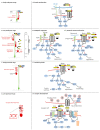Reelin Functions, Mechanisms of Action and Signaling Pathways During Brain Development and Maturation
- PMID: 32604886
- PMCID: PMC7355739
- DOI: 10.3390/biom10060964
Reelin Functions, Mechanisms of Action and Signaling Pathways During Brain Development and Maturation
Abstract
During embryonic development and adulthood, Reelin exerts several important functions in the brain including the regulation of neuronal migration, dendritic growth and branching, dendritic spine formation, synaptogenesis and synaptic plasticity. As a consequence, the Reelin signaling pathway has been associated with several human brain disorders such as lissencephaly, autism, schizophrenia, bipolar disorder, depression, mental retardation, Alzheimer's disease and epilepsy. Several elements of the signaling pathway are known. Core components, such as the Reelin receptors very low-density lipoprotein receptor (VLDLR) and Apolipoprotein E receptor 2 (ApoER2), Src family kinases Src and Fyn, and the intracellular adaptor Disabled-1 (Dab1), are common to most but not all Reelin functions. Other downstream effectors are, on the other hand, more specific to defined tasks. Reelin is a large extracellular protein, and some aspects of the signal are regulated by its processing into smaller fragments. Rather than being inhibitory, the processing at two major sites seems to be fulfilling important physiological functions. In this review, I describe the various cellular events regulated by Reelin and attempt to explain the current knowledge on the mechanisms of action. After discussing the shared and distinct elements of the Reelin signaling pathway involved in neuronal migration, dendritic growth, spine development and synaptic plasticity, I briefly outline the data revealing the importance of Reelin in human brain disorders.
Keywords: Reelin; cellular pathways; cerebral cortex; dendrites; embryonic development; migration; neurodevelopmental disorders; neuron; postnatal maturation; proteolytic processing; signal transduction; synapse.
Conflict of interest statement
The author declares no competing financial interests.
Figures


Similar articles
-
The functions of Reelin in membrane trafficking and cytoskeletal dynamics: implications for neuronal migration, polarization and differentiation.Biochem J. 2017 Sep 7;474(18):3137-3165. doi: 10.1042/BCJ20160628. Biochem J. 2017. PMID: 28887403 Review.
-
Crk and Crk-like play essential overlapping roles downstream of disabled-1 in the Reelin pathway.J Neurosci. 2008 Dec 10;28(50):13551-62. doi: 10.1523/JNEUROSCI.4323-08.2008. J Neurosci. 2008. PMID: 19074029 Free PMC article.
-
Intersectin 1 is a component of the Reelin pathway to regulate neuronal migration and synaptic plasticity in the hippocampus.Proc Natl Acad Sci U S A. 2017 May 23;114(21):5533-5538. doi: 10.1073/pnas.1704447114. Epub 2017 May 8. Proc Natl Acad Sci U S A. 2017. PMID: 28484035 Free PMC article.
-
Interfering of the Reelin/ApoER2/PSD95 Signaling Axis Reactivates Dendritogenesis of Mature Hippocampal Neurons.J Cell Physiol. 2017 May;232(5):1187-1199. doi: 10.1002/jcp.25605. Epub 2016 Oct 25. J Cell Physiol. 2017. PMID: 27653801
-
Regulation of Reelin functions by specific proteolytic processing in the brain.J Biochem. 2021 Jul 3;169(5):511-516. doi: 10.1093/jb/mvab015. J Biochem. 2021. PMID: 33566063 Review.
Cited by
-
Multi-Dimensional Transcriptome Analysis Reveals Modulation of Cholesterol Metabolism as Highly Integrated Response to Brain Injury.Front Neurosci. 2021 May 14;15:671249. doi: 10.3389/fnins.2021.671249. eCollection 2021. Front Neurosci. 2021. PMID: 34054419 Free PMC article.
-
Functional Diversity of Neuronal Cell Adhesion and Recognition Molecule L1CAM through Proteolytic Cleavage.Cells. 2022 Sep 30;11(19):3085. doi: 10.3390/cells11193085. Cells. 2022. PMID: 36231047 Free PMC article. Review.
-
Beyond Glycolysis: Aldolase A Is a Novel Effector in Reelin-Mediated Dendritic Development.J Neurosci. 2024 Oct 16;44(42):e0072242024. doi: 10.1523/JNEUROSCI.0072-24.2024. J Neurosci. 2024. PMID: 39227156 Free PMC article.
-
Reln-Dab1 pathway mitigates retinal ganglion cell apoptosis in retinal ischemia-reperfusion injury.Cell Death Dis. 2025 May 29;16(1):423. doi: 10.1038/s41419-025-07742-6. Cell Death Dis. 2025. PMID: 40442071 Free PMC article.
-
Reelin Signaling and Synaptic Plasticity in Schizophrenia.Brain Sci. 2023 Dec 11;13(12):1704. doi: 10.3390/brainsci13121704. Brain Sci. 2023. PMID: 38137152 Free PMC article. Review.
References
-
- De Rouvroit C.L., Goffinet A.M. Factors Influencing Mammalian Kidney Development: Implications for Health in Adult Life. Volume 150. Springer Science and Business Media; Berlin/Heidelberg, Germany: 1998. The Reeler Mouse as a Model of Brain Development; pp. 1–106. - DOI
Publication types
MeSH terms
Substances
Grants and funding
LinkOut - more resources
Full Text Sources
Research Materials
Miscellaneous

